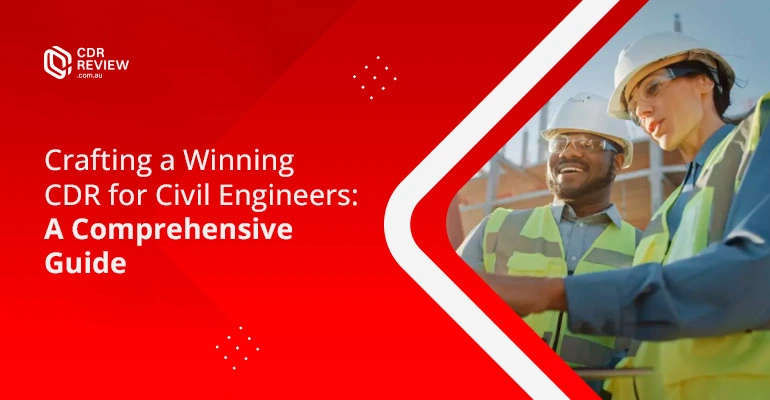Crafting a Winning CDR for Civil Engineers: A Comprehensive Guide

Crafting a Winning CDR for Civil Engineers: A Comprehensive Guide
Civil engineers aiming to migrate and work in Australia often encounter the term “Competency Demonstration Report” (CDR). A well-crafted CDR can be the key to opening doors for your professional aspirations. Engineers Australia (EA) assesses it to determine whether your qualifications and skills meet Australian standards. This blog is a comprehensive guide to writing an effective CDR for civil engineers.
What is a CDR?
The Competency Demonstration Report (CDR) is a critical document required by Engineers Australia for engineers seeking migration under the Skilled Migration category. It provides evidence of your engineering skills and competencies, focusing on three core elements:
- Continuing Professional Development (CPD): Highlights your engineering knowledge and lifelong learning.
- Three Career Episodes: Demonstrate your skills through detailed accounts of your engineering projects.
- Summary Statement: Summarizes how the Career Episodes meet the competency standards.
Why is CDR Important for Civil Engineers?
Australia’s booming infrastructure industry offers immense opportunities for civil engineers. However, Engineers Australia mandates a CDR to ensure applicants meet Australian standards of practice. A strong CDR validates your expertise and reflects your potential to contribute to the nation’s infrastructure.
Key Elements of a Civil Engineer’s CDR
1. Continuing Professional Development (CPD)
Your CPD section demonstrates your commitment to keeping your skills up to date. It should include:
- Workshops, seminars, or conferences attended.
- Online or offline courses completed.
- Professional memberships.
- Self-study initiatives like reading journals or technical publications.
Example:
- Attended a workshop on “Sustainable Urban Drainage Systems.
- Completed an online course on “Advanced Concrete Technology.
- Member of the Institution of Engineers, India.
2. Career Episodes
The Career Episodes are the heart of your CDR. Each episode must highlight a specific project, role, or task where you demonstrated core engineering skills.
Structure of a Career Episode:
- Introduction: Brief about the project, your role, and the period.
- Background: Context of the project, objectives, and organizational structure.
- Personal Engineering Activity: Your role, tasks performed, and challenges tackled.
- Summary: Reflect on the project’s outcomes and your learning experience.
Example Projects for Civil Engineers:
- Design and analysis of a multi-story building.
- Supervision of a highway construction project.
- Development of a water supply and sewage treatment system.
3. Summary Statement
This section maps your Career Episodes to the competency elements outlined by Engineers Australia. Use a table format to link specific paragraphs in your episodes to the required competencies.
Tips for Writing an Impressive CDR
1. Understand the Competency Standards
Engineers Australia has a list of competencies categorized under knowledge, skills, and professional attributes. Tailor your CDR to showcase these competencies.
2. Be Specific and Personal
Avoid generic statements. Focus on what you did rather than what the team achieved. Highlight your problem-solving skills, technical expertise, and decision-making ability.
3. Use Active Voice
Active voice lends clarity and ownership to your writing. For instance:
- Instead of: “The project was completed successfully.”
- Use: “I completed the project by implementing innovative drainage solutions.”
4. Avoid Plagiarism
Engineers Australia uses advanced plagiarism detection tools. Ensure that your CDR is original, even if you’re referring to samples.
5. Proofread and Edit
A single grammatical error can diminish the impact of your CDR. Review your document for errors, or consider professional editing services.
Common Challenges Civil Engineers Face in CDR Writing
1. Identifying Relevant Projects
Civil engineers often work in teams, making it challenging to identify individual contributions. Choose projects where your role was pivotal.
2. Technical Complexity
Balancing technical details with clear communication is tricky. Avoid overloading your CDR with jargon, but ensure technical accuracy.
3. Time Constraints
Crafting a CDR takes time. Many engineers struggle to balance this task with their professional commitments. Planning and time management are crucial.
Sample Career Episode for a Civil Engineer
Title: Design of a Sustainable Bridge Structure
Introduction:
This project was undertaken during my tenure at XYZ Construction Ltd., from June 2020 to December 2021. As the project lead, my responsibility was to design a sustainable bridge over the River Z.
Background:
The bridge was part of a national initiative to connect rural and urban areas. The main challenge was designing a cost-effective yet durable structure in a flood-prone region. I collaborated with structural engineers and hydrologists to develop a resilient design.
Personal Engineering Activity:
- Conducted feasibility studies, including topographical surveys and soil analysis.
- Designed a steel arch bridge with high load-bearing capacity.
- Developed a flood-resistant foundation by integrating pile foundation techniques.
- Coordinated with the procurement team to source eco-friendly materials.
Summary:
The bridge was completed within the timeline and budget. It improved connectivity and reduced travel time for residents by 40%. This project honed my skills in sustainable design and team leadership.
Visualizing Your CDR
While your CDR is primarily text-based, visual aids like flowcharts, graphs, and tables can enhance understanding.
- Flowcharts: Illustrate processes like project workflows.
- Graphs: Showcase performance metrics, like load-bearing tests.
- Tables: Summarize data, such as material comparisons.
Checklist Before Submission
- Is your CPD up-to-date and relevant?
- Have you written three distinct Career Episodes?
- Does your Summary Statement link competencies?
- Have you followed Engineers Australia’s guidelines on formatting and structure?
- Is your content original and free from plagiarism?
Professional Assistance for CDR Writing
If you’re struggling with time or clarity, consider seeking professional help. Many services specialize in drafting CDRs tailored to civil engineers. Ensure they provide plagiarism-free and customised content.
Conclusion
A compelling CDR can significantly impact your chances of migrating as a civil engineer to Australia. By understanding the structure, focusing on personal contributions, and adhering to Engineers Australia’s guidelines, you can craft a CDR that stands out.
Invest time in preparing your CDR, as it’s not just a document but a reflection of your professional journey and aspirations. With careful planning and execution, your dream of working in Australia as a civil engineer can become a reality.



